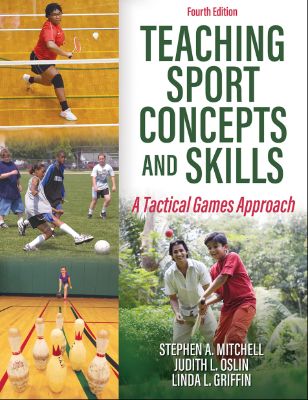Teaching Sport Concepts and Skills

Lýsing:
This worldwide top-selling text on the tactical games approach is stronger than ever. The fourth edition of Teaching Sport Concepts and Skills: A Tactical Games Approach adds four new chapters, more lesson and unit plans, and more detailed guidance in addressing broad ranges of student abilities than ever before. It offers the same stellar foundation for understanding the principles behind the approach, and instruction in applying the approach, to help students learn the concepts and develop the skills involved in a variety of sports.
Elementary school teachers will use games to teach the basic concepts and tactics of invasion sports, net and wall sports, striking and fielding sports, and target sports. Middle school and high school instructors will guide students in developing sport-specific technical skills for 12 sports, including soccer, lacrosse, flag football, tennis, basketball, and volleyball. The book has four new chapters that will help you do the following: Align the tactical games approach to content standards in the United States and other countries Use technology in tactical games teaching and assessment Use the games to teach social justice Develop approaches to teaching social and emotional learning (SEL) through tactical gamesTeaching Sport Concepts and Skills offers more than 350 detailed lesson and unit plans that can be used as is or be easily modified and incorporated into an existing curriculum.
More than 240 diagrams throughout the lessons make it easy to set up and execute the games. There are 14 video clips, delivered on HKPropel, that show some lessons in action—for example, the volleyball segments show complete question-and-answer sessions, highlighting an effective way to make sure students are understanding the lesson. Also available on HKPropel are reproducible forms, including a team contract, assessments, and game scenario worksheets for tactical problem solving.
(For each thumbnail reproducible worksheet shown in the book, readers can download the full-size versions from HKPropel. ) These resources will help teachers put concepts from the text into use with their students. Teaching Sport Concepts and Skills is organized into three parts: Part I offers a thorough understanding of the tactical games approach—preparing and teaching students, transferring tactical knowledge, planning the curriculum, assessing learner performance, using games to teach social justice and to take social emotional learning into account, and more.
Part II provides lesson plans for varying levels of complexity—with modifications and progressions—for invasion games, net and wall games, striking and fielding games, and target games, all at the elementary school level. The authors take great care in helping readers understand how to individualize instruction for novice, developing, and advanced performers by either reducing or increasing the challenges involved with the tasks.
In part III, secondary-level teachers can choose from lesson plans for various levels of play in 12 sports. Teaching Sport Concepts and Skills offers expert instruction and an array of multilevel games that provide an exciting and interactive environment for learning in all domains. Current and future teachers will learn how to structure positive and engaging learning experiences that set the stage for students to improve their performance, develop problem-solving skills, and enhance their lifelong enjoyment of sport.
Annað
- Höfundar: Stephen A. Mitchell, Judith L. Oslin, Linda L. Griffin
- Útgáfa:4
- Útgáfudagur: 2020-10-02
- Engar takmarkanir á útprentun
- Engar takmarkanir afritun
- Format:ePub
- ISBN 13: 9781492590910
- Print ISBN: 9781492590484
- ISBN 10: 1492590916
Efnisyfirlit
- Title Page
- Copyright
- Dedication
- Contents
- Acknowledgments
- Introduction
- Part I: Tactical Games Teaching
- Chapter 1. Tactical Games Explanation and Review
- Rationale for a Tactical Approach
- Game Frameworks
- Game Performance
- Levels of Tactical Complexity
- Teaching Tactical Awareness and Skill Acquisition
- Implementing a Tactical Games Approach Using This Book
- Summary
- Chapter 2. Preparing Students for a Tactical Games Approach
- Training Students to Play Small-Sided Games
- Teaching Appropriate Sport Behavior
- Teaching Rules and Routines
- Teaching During Game Play
- Physical Activity Considerations in Games Teaching and Learning
- Pedagogical Considerations and Strategies for Promoting Moderate to Vigorous Physical Activity
- Summary
- Chapter 3. Getting Started With Tactical Games Teaching
- Conceptual Framework for Planning Tactical Teaching
- Putting the Planning Framework Into Action
- The Teacher and the Change Process
- Implementing Practices
- Summary
- Chapter 4. Transfer as a Principle of Games Teaching and Learning
- Transfer of Tactical Knowledge in Games
- Implications for Curriculum Development
- Ultimate as an Example of Transfer in Action
- Summary
- Chapter 5. Tactical Games Curriculum Model
- Assumptions Underpinning a Tactical Games Curriculum
- Conceptual Framework
- Model-Based Instruction
- Summary
- Chapter 6. Assessing Outcomes
- Assessment Beliefs
- Assessment Strategies
- Assessing Learning Outcomes
- Summary
- Chapter 7. Aligning a Tactical Games Model With Content Standards
- Content Standards in the United States
- Content Standards in England
- Content Standards in Australia
- Content Standards in Singapore
- Tactical Games Alignment With the International Baccalaureate
- Summary
- Chapter 8. Digital Technology for Teaching Tactical Games and Enhancing Skill Development
- Digital Planning
- Tactical Awareness and Skill Development
- Formative Assessment and Self-Assessment
- Summary
- Chapter 9. Teaching and Learning Social Justice Through Inventing Games
- Revisiting the True Meaning of Competition
- Teaching Social Justice and Democracy in Action
- Summary
- Chapter 10. Integrating Social and Emotional Learning Into a Tactical Games Approach
- Overview of Social and Emotional Learning
- Overview of SEL Teachers and Their Classrooms
- Situating Social and Emotional Learning Within a Tactical Games Approach
- Summary
- Chapter 1. Tactical Games Explanation and Review
- Chapter 11. Invasion Games at the Elementary Level
- Elementary Invasion Games Tactics
- Levels of Elementary Invasion Game Complexity
- Modifications for Elementary Invasion Games
- Progressions for Teaching Elementary Invasion Games
- Scope and Sequence
- Level I
- Level II
- Level III
- Teaching Cues for Invasion Game Skills
- Summary
- Chapter 12. Net and Wall Games at the Elementary Level
- Elementary Net Games Tactics and Levels of Game Complexity
- Modifications for Elementary Net and Wall Games
- Progressions for Teaching Elementary Net and Wall Games
- Level I
- Level II
- Level III
- Summary
- Chapter 13. Striking and Fielding Games at the Elementary Level
- Elementary Striking and Fielding Games Tactics
- Levels of Elementary Striking and Fielding Game Complexity
- Modifications for Elementary Striking and Fielding Games
- Progressions for Teaching Elementary Striking and Fielding Games
- Level I
- Level II
- Level III
- Level IV
- Summary
- Chapter 14. Target Games at the Elementary Level
- Elementary Target Games Tactics and Levels of Game Complexity
- Modifications for Elementary Target Games
- Progressions for Teaching Elementary Target Games
- Bowling as an Exemplar for Teaching Target Games
- Target Games Lessons
- Level I
- Level II
- Level III
- Summary
- Chapter 15. Soccer
- Level I
- Level II
- Level III
- Level IV
- Level V
- Summary
- Chapter 16. Basketball
- Level I
- Level II
- Level III
- Level IV
- Summary
- Chapter 17. Lacrosse
- Level I
- Level II
- Level III
- Level IV
- Summary
- Chapter 18. Rugby
- Level I
- Level II
- Level III
- Summary
- Chapter 19. Flag Football
- Level I
- Level II
- Summary
- Chapter 20. Volleyball
- Volleyball Tactics
- Teaching Volleyball
- Levels of Tactical Complexity
- Level I
- Level II
- Level III
- Level IV
- Level V
- Summary
- Chapter 21. Badminton
- Level I
- Level II
- Level III
- Summary
- Chapter 22. Tennis
- Level I
- Level II
- Level III
- Summary
- Chapter 23. Softball
- Level I
- Level II
- Level III
- Level IV
- Summary
- Chapter 24. Cricket
- Level I
- Level II
- Level III
- Summary
- Chapter 25. Golf
- Safety
- Instruction Tips
- Tactical Reality Golf
- Level I
- Level II
- Summary
- Chapter 26. Bowling
- Organization of Lanes and Equipment
- Instruction Tips
- Level I
- Level II
- Level III
- Level IV
- Summary
UM RAFBÆKUR Á HEIMKAUP.IS
Bókahillan þín er þitt svæði og þar eru bækurnar þínar geymdar. Þú kemst í bókahilluna þína hvar og hvenær sem er í tölvu eða snjalltæki. Einfalt og þægilegt!Rafbók til eignar
Rafbók til eignar þarf að hlaða niður á þau tæki sem þú vilt nota innan eins árs frá því bókin er keypt.
Þú kemst í bækurnar hvar sem er
Þú getur nálgast allar raf(skóla)bækurnar þínar á einu augabragði, hvar og hvenær sem er í bókahillunni þinni. Engin taska, enginn kyndill og ekkert vesen (hvað þá yfirvigt).
Auðvelt að fletta og leita
Þú getur flakkað milli síðna og kafla eins og þér hentar best og farið beint í ákveðna kafla úr efnisyfirlitinu. Í leitinni finnur þú orð, kafla eða síður í einum smelli.
Glósur og yfirstrikanir
Þú getur auðkennt textabrot með mismunandi litum og skrifað glósur að vild í rafbókina. Þú getur jafnvel séð glósur og yfirstrikanir hjá bekkjarsystkinum og kennara ef þeir leyfa það. Allt á einum stað.
Hvað viltu sjá? / Þú ræður hvernig síðan lítur út
Þú lagar síðuna að þínum þörfum. Stækkaðu eða minnkaðu myndir og texta með multi-level zoom til að sjá síðuna eins og þér hentar best í þínu námi.
Fleiri góðir kostir
- Þú getur prentað síður úr bókinni (innan þeirra marka sem útgefandinn setur)
- Möguleiki á tengingu við annað stafrænt og gagnvirkt efni, svo sem myndbönd eða spurningar úr efninu
- Auðvelt að afrita og líma efni/texta fyrir t.d. heimaverkefni eða ritgerðir
- Styður tækni sem hjálpar nemendum með sjón- eða heyrnarskerðingu
- Gerð : 208
- Höfundur : 13910
- Útgáfuár : 2013
- Leyfi : 379


